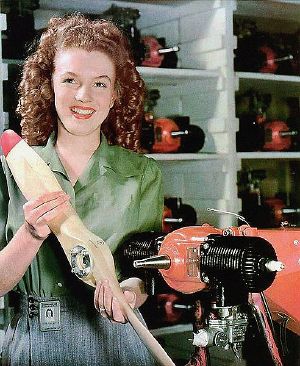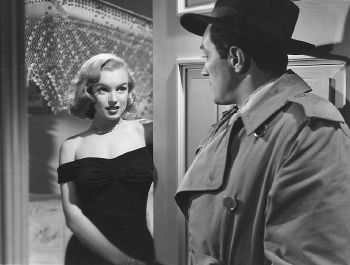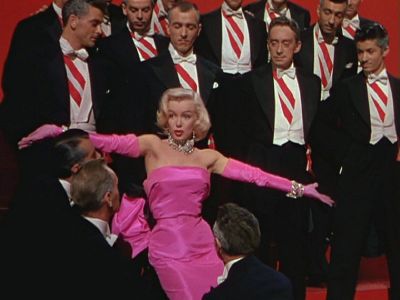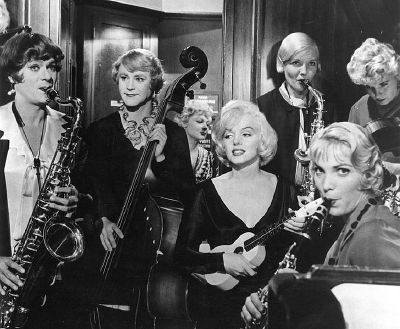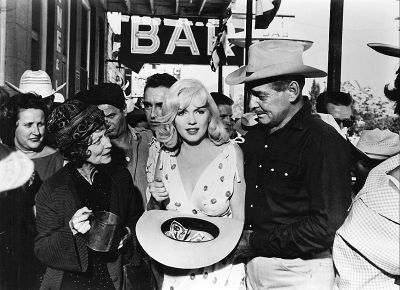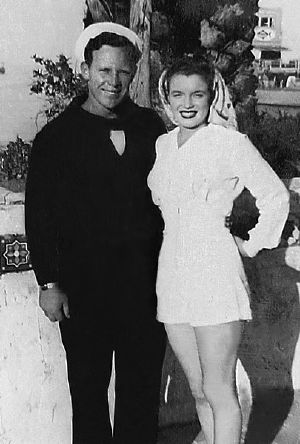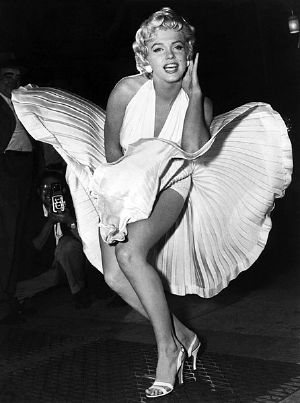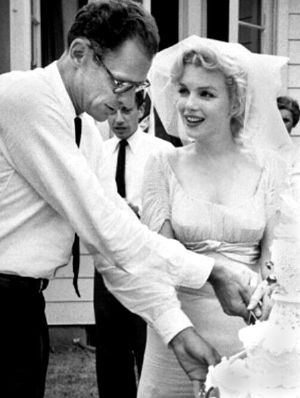Marilyn Monroe
| Marilyn Monroe | |
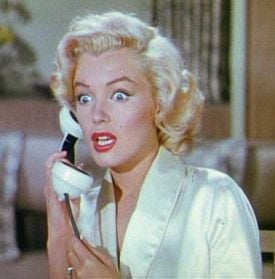 Monroe in Gentlemen Prefer Blondes | |
| Birth name: | Norma Jeane Mortensen |
|---|---|
| Date of birth: | June 1, 1926 Los Angeles, California, USA |
| Date of death: | August 5, 1962 Los Angeles, California, USA |
Marilyn Monroe (June 1, 1926 – August 5, 1962) was an iconic American actress, singer and model. Decades after her death, she remains one of the twentieth century's most famous movie stars and pop icons. After acting in small roles for several years, she gradually became known for her comedic skills and screen presence, going on to become one of the most popular movie stars of the 1950s. Later in her career, she worked towards serious roles with a measure of success. However, long standing emotional problems were exacerbated by disappointments in both career and personal life during her later years.
Her birth in a charity ward and unstable early life as a foster child and ward of the state provided little nurturing and emotional security during her formative years. Later, a succession of celebrity marriages garnered publicity but failed to provide support for her increasingly reckless and unstable emotional state. Her death, apparently by suicide, has attracted much attention and has fueled conspiracy theories.
Marilyn Monroe remains one of the biggest names in twentieth century film. She personified glamor and was one of the most celebrated sex symbols of the film industry. Her popularity influenced Hollywood to cast female roles with increasing sexual explicitness, often at the expense of serious dramatic treatment of women's lives. Always anxious that it was her looks that won her roles, she wanted to be taken seriously as an actress by the end of her career she had won a number of awards, including three Golden Globe awards. "Today, the name "Marilyn Monroe" is synonymous with beauty, sensuality and effervescence", says one biographer.[1]
Early life
She was born Norma Jeane Mortenson in the charity ward of the Los Angeles County Hospital. According to biographer Fred Lawrence Guiles, her grandmother, Della Monroe Grainger, had her baptized Norma Jean Baker by Aimee Semple McPherson.
Her mother, Gladys Pearl Monroe, had returned from Kentucky where her ex-husband had kidnapped their children, Robert and Berniece. Some of Monroe's biographers portray Jasper Baker as vicious and brutal. Berniece recounted in My Sister Marilyn that when Robert later suffered a series of physical ailments, Baker refused to seek proper medical attention for him; the boy died in 1933.[2]
Many biographers believe Norma Jeane's biological father was Charles Stanley Gifford, a salesman for the studio where Gladys worked as a film-cutter. Marilyn's birth certificate lists Gladys' second husband, Martin Edward Mortenson, as the father. While Mortenson left Gladys before Norma Jeane's birth, some biographers think he was the father. In an interview with Lifetime, James Dougherty said Norma Jeane believed that Gifford was her father. Whoever the biological father was, he played no part in Marilyn's life.
Unable to persuade Della to take Norma Jeane, Gladys placed her with foster parents Albert and Ida Bolender of Hawthorne, where she lived until she was seven. Gladys visited Norma Jeane every Saturday. One day, she announced that she had bought a house. A few months after they had moved in, Gladys suffered a mental breakdown. In the book, Monroe recalls her mother "screaming and laughing" as she was forcibly removed to the State Hospital in Norwalk. Gladys's father, Otis, died in an asylum near San Bernardino from syphilis.
Norma Jeane was declared a ward of state and Gladys's best friend, Grace McKee, became her guardian. After McKee married in 1935, Norma Jeane was sent to a Los Angeles orphanage and then to a succession of foster homes where she was allegedly abused and neglected.
Grace Goddard and her new husband moved to the east and could not take her. Grace worried about Norma Jeane having to return to the orphanage, so she spoke to the mother of James Dougherty. Mrs. Dougherty approached her son, who agreed to take Norma Jeane out on dates, paid for by Grace. They married two weeks after she turned 16.
Career
Early years
While her husband served in the Merchant Marines during World War II, Norma Jeane Dougherty moved in with her mother-in-law, and started to work in the Radioplane Company factory Reginald Denny, spraying airplane parts with fire retardant and inspecting parachutes. Army photographer David Conover scouted local factories taking photos for a YANK magazine article about women contributing to the war effort. He saw her potential as a model and she was soon signed by The Blue Book modeling agency.
She became one of their most successful models, appearing on dozens of magazine covers. In 1946 she came to the attention of talent scout Ben Lyon. He arranged a screen test for her with 20th Century Fox. She passed and was offered a standard six-month contract with a starting salary of $75 per week.
Lyon suggested "Marilyn" to be her stage name, since Norma Jeane wasn't considered commercial enough. She came up with her mother's maiden name "Monroe." Thus the 20-year old Norma Jeane Baker became "Marilyn Monroe." During her first half year at Fox, Monroe was given no work. Instead, she learned about hair, make-up, costumes, acting, and lighting. After six months, Fox renewed her contract. She was given minor appearances in Scudda Hoo! Scudda Hay! and Dangerous Years, both released in 1947. Both films failed at the box office and Fox decided not to renew her contract again. Monroe returned to modelling and began to network and make contacts in Hollywood.
In 1948, a six-month stint at Columbia Pictures saw her star in Ladies of the Chorus, but the low-budget musical was not a success and Monroe was dropped yet again. She then met one of Hollywood's top agents, Johnny Hyde, who had Fox re-sign her after MGM had turned her down. Fox Vice-President Darryl F. Zanuck was not convinced of Monroe's potential. However, due to Hyde's persistence, she gained supporting parts in All About Eve and The Asphalt Jungle. Even though the roles were small, movie-goers as well as critics took notice.
The next two years were filled with inconsequential roles in standard fare such as We're Not Married! and Love Nest. However, RKO executives used her to boost box office potential of the Fritz Lang production Clash By Night. After the film performed well, Fox employed a similar tactic and she was cast as the ditsy receptionist in the Cary Grant/Ginger Rogers comedy Monkey Business. Critics no longer ignored her, and both films' success at the box office was partly attributed to Monroe's growing popularity.
Fox finally gave her a starring role in 1952 with Don't Bother to Knock. It was a cheaply made B-movie, and although the reviews were mixed, many claimed that it demonstrated Monroe's ability and confirmed that she was ready for more leading roles.
Stardom
Monroe proved she could carry a big-budget film when she received star billing for Niagara in 1953. Movie critics focused on Monroe's connection with the camera as much as the sinister plot. She played the part of an unbalanced woman of easy virtue who is planning to murder her husband.
Over the following months, Gentlemen Prefer Blondes and How To Marry A Millionaire cemented Monroe's status as an A-List screen actress and she became one of the world's biggest movie stars. The lavish Technicolor comedy films established Monroe's "dumb blonde" on-screen persona.
In Gentlemen Prefer Blondes, Monroe's turn as the gold-digging showgirl Lorelei Lee won her rave reviews, and the scene where she sings "Diamonds Are a Girl's Best Friend" has had an impact on popular culture, inspiring the likes of Madonna and Kylie Minogue. In the Los Angeles premiere of the film, Monroe and co-star Jane Russell pressed their foot- and handprints in the cemented forecourt of Grauman's Chinese Theatre.
In How to Marry a Millionaire, Monroe was teamed up with Lauren Bacall and Betty Grable. She played a short-sighted dumb blonde, and even though the role was stereotype, critics took note of her comedic timing.
Her next two films, the western River of No Return and the musical There's No Business Like Show Business, were not successful. Monroe got tired of the roles that Zanuck assigned her. After completing work on The Seven Year Itch in early 1955, she broke her contract and fled Hollywood to study acting at The Actors Studio in New York. Fox would not accede on her contract demands and insisted she return to start work on productions she considered inappropriate, such as The Girl in Pink Tights (which was never filmed), The Girl in the Red Velvet Swing. and How to Be Very, Very Popular.
Monroe refused to appear in these films and stayed in New York. As The Seven Year Itch raced to the top of the box office in the summer of 1955, and with Fox starlets Jayne Mansfield and Sheree North failing to click with audience, Zanuck admitted defeat and Monroe triumphantly returned to Hollywood. A new contract was drawn up, giving Monroe an approval of the director as well as the option to act in other studios' projects.
The first film to be made under the contract was Bus Stop, (1956) directed by Joshua Logan. She performed the role of Chérie, a saloon bar singer who falls in love with a cowboy. Monroe deliberately appeared badly made-up and non-glamorous.
She was nominated for a Golden Globe for the performance and praised by critics. Bosley Crowther of The New York Times proclaimed: "Hold on to your chairs, everybody, and get set for a rattling surprise. Marilyn Monroe has finally proved herself an actress."[3] In his autobiography, Movie Stars, Real People and Me, director Joshua Logan said, "I found Marilyn to be one of the great talents of all time ... She struck me as being a much brighter person than I had ever imagined, and I think that was the first time I learned that intelligence and, yes brilliance have nothing to do with education."[4]
Monroe formed her own production company with friend and photographer Milton H. Greene. Marilyn Monroe Productions released its first and only film The Prince and the Showgirl in 1957 to mixed reviews. Along with executive-producing the film, she starred opposite the acclaimed British actor Laurence Olivier, who directed it.
Olivier got furious at her habit of being late to the set, as well as her dependency on her drama coach, Paula Strasberg. While Monroe's reputation in the film industry for being difficult grew, her performance was hailed by critics, especially in Europe, where she was handed the David di Donatello, the Italian equivalent of the Academy Award, as well as the French Crystal Star Award. She was also nominated for the British BAFTA award.
Later years
In 1959 she scored the biggest hit of her career starring alongside Tony Curtis and Jack Lemmon in Billy Wilder's comedy Some Like It Hot. After shooting finished, Wilder publicly blasted Monroe for her difficult on-set behavior. Soon, however, Wilder's attitude softened, and he hailed her a great comedienne. Some Like It Hot is consistently rated as one of the best films ever made. Monroe's performance earned her a Golden Globe for best actress in musical or comedy. The New York Times proclaimed Monroe a "talented comedienne."
After Some Like It Hot, Monroe shot Let's Make Love directed by George Cukor and co-starring Yves Montand. Monroe, Montand, and Cukor all considered the script subpar, yet Monroe was forced to shoot the picture because of her obligations to Twentieth Century-Fox. While the film was not a commercial or critical success, it included one of Monroe's legendary musical numbers, Cole Porter's "My Heart Belongs to Daddy."
Arthur Miller (who later married her) wrote what became her and her co-star Clark Gable's last completed film, The Misfits. The exhausting shoot took place in the hot Nevada desert. Monroe's tardiness became chronic and the shoot was troublesome. Despite this, Monroe, Gable and Montgomery Clift delivered performances that are considered excellent by contemporary movie critics. Monroe became friends with Clift, with whom she felt a deep connection. Gable said of Marilyn:
Marilyn is a kind of ultimate. She is uniquely feminine. Everything she does is different, strange, and exciting, from the way she talks to the way she uses that magnificent torso. She makes a man proud to be a man.[5]
Monroe returned to Hollywood to resume filming on the George Cukor comedy Something's Got to Give, but the film was never finished and has become legendary for "problems on the set". In May 1962, she made her last significant public appearance, singing Happy Birthday at a televised birthday party for Pres. John F. Kennedy.
Already in a financial strain due to production costs of Cleopatra, starring Elizabeth Taylor, Fox dropped Monroe from the film and replaced her with Lee Remick. However, co-star Dean Martin was unwilling to work with anyone else but Monroe. She was rehired.
Monroe conducted a lengthy interview with LIFE Magazine,[6] in which she expressed bitterness over Hollywood labeling her as a dumb blonde and her love for her audience. She also did a photo shoot for Vogue, and began discussing a future film project with Gene Kelly and Frank Sinatra.[7] She was planning to star in a biopic as Jean Harlow. Other projects being considered for her were What a Way to Go! and a musical version of A Tree Grows In Brooklyn.
Before the shooting of Something's Got to Give resumed, Monroe was found dead in her Los Angeles home, on the morning of August 5, 1962. She remains one of the twentieth century's most legendary public figures and archetypal Hollywood movie stars.
Marriages
James Dougherty
Monroe married James Dougherty on June 19, 1942, when she was 16 years old. In The Secret Happiness of Marilyn Monroe and To Norma Jeane with Love, Jimmie, he claimed they were in love but dreams of stardom lured her away. She always maintained theirs was a marriage of convenience arranged by Grace Goddard. She moved out of her mother-in-law's home and stopped writing to Dougherty. She filed for divorce in Las Vegas, Nevada; it was finalized on September 13, 1946.
Joe DiMaggio
In 1951 baseball player Joe DiMaggio saw a picture of Monroe with two Chicago White Sox players, but did not ask the man who arranged the stunt to set up a date until 1952. She wrote in My Story that she did not want to meet him, fearing a stereotypical jock.
They eloped at San Francisco's City Hall on January 14, 1954. During the honeymoon, they traveled to Japan and along the way she was asked to visit American soldiers in Korea by U.S. General Christenberry. She performed ten shows over four days in freezing temperatures for over 100,000 servicemen.
Back home, she wrote him a letter about her dreams for their future, dated February 28, 1954:
"My Dad, I don't know how to tell you just how much I miss you. I love you till my heart could burst…. I want to just be where you are and be just what you want me to be…. I want someday for you to be proud of me as a person and as your wife and as the mother of the rest of your children (two at least! I've decided)…."
Joe, knowing the power and hollowness of fame, wanted desperately to head off what he was convinced was her "collision-course with disaster." Friends claimed that DiMaggio became more controlling as Monroe grew more defiant. On September 14, 1954, she filmed the now-iconic skirt-blowing scene for The Seven Year Itch in front of New York's Trans-Lux Theater. DiMaggio just blew up." The couple later had a "yelling battle" in the theater lobby. Her makeup man Allan Snyder recalled Monroe later appeared on set with bruises on her upper arms. She filed for divorce on grounds of mental cruelty 274 days after the wedding.
Years later, she turned to him for help. In February 1961, her psychiatrist arranged for her to be admitted to the Payne Whitney Psychiatric Clinic. Unable to check herself out, she called DiMaggio, who secured her release. She later joined him in Florida. Their "just good friends" claim did not stop rumors of remarriage. Archive footage shows Bob Hope jokingly dedicated Best Song nominee The Second Time Around to them at the 1960 Academy Awards telecast.
According to legend, on August 1, 1962 DiMaggio—alarmed by how his ex-wife had fallen in with people he felt detrimental to her, such as Frank Sinatra and his "Rat Pack"—quit his job with a PX supplier to ask her to remarry him.
He claimed her body five days later and arranged her funeral, barring Hollywood's elite. For 20 years, he had a dozen red roses delivered to her crypt three times a week. Unlike her other two husbands, he never talked about her publicly, never wrote a "tell-all," nor remarried. He died on March 8, 1999, of lung cancer.
Arthur Miller
On June 29, 1956, Monroe married playwright Arthur Miller, whom she had first met in 1951, in a civil ceremony in White Plains, New York. Nominally raised as a Christian, she converted to Judaism before marrying Miller. After she finished shooting The Prince and the Showgirl, the couple returned to the United States from England and discovered she was pregnant. However, she suffered from endometriosis and the pregnancy was found to be ectopic. A subsequent pregnancy ended in miscarriage, as noted in the Monroe biographies written by Anthony Summers, Fred Lawrence Guiles, and Donald Spoto.
By 1958, she was the couple's main breadwinner. While paying alimony to Miller's first wife, her husband reportedly charged her production company for buying and shipping a Jaguar to the United States.
Miller's screenplay for The Misfits was meant to be a Valentine gift for his wife, but by the time filming started in 1960 their marriage was broken beyond repair. A Mexican divorce was granted on January 24, 1961. On February 17, 1962, Miller married Inge Morath, one of the Magnum photographers recording the making of The Misfits.
In January 1964, Miller's play After the Fall opened, featuring a beautiful and devouring shrew named Maggie. The similarities between Maggie and Monroe did not go unnoticed by audiences and critics (including Helen Hayes), many of whom sympathized with the fact that she was no longer alive and could not defend herself.
Simone Signoret noted in her autobiography the morbidity of Miller and Elia Kazan resuming their professional association "over a casket". In interviews and in his autobiography, Miller insisted that Maggie was not based on Monroe. However, he never pretended that his last Broadway-bound work, Finishing the Picture, was not based on the making of The Misfits. He told Vanity Fair magazine that she was "highly self-destructive" and what "killed" her was not some conspiracy, but the fact that she was Marilyn Monroe. Miller died on February 10, 2005, at the age of 89.
Death and aftermath
Monroe was found dead in the bedroom of her Brentwood, Los Angeles, California home by her housekeeper Eunice Murray on August 5, 1962. She was 36 years old. Her death was ruled as an overdose from the sleeping pill Nembutal. Several conspiracy theories have surfaced in the decades after her death. There is also speculation that her death was accidental, but the official cause of death was "probable suicide" by acute barbiturate poisoning.
On August 8, 1962, Monroe was buried at Corridor of Memories, #24, at the Westwood Village Memorial Park Cemetery in Westwood, Los Angeles, California. Allegedly, this was the day she had planned to remarry DiMaggio. Lee Strasberg delivered the eulogy. "Her death," wrote LIFE Magazine "has diminished the loveliness of the world in which we live."[8]
Administration of estate
In her will, dated January 16, 1961, Monroe left Lee Strasberg control of 75 percent of her estate. She expressed her desire that Strasberg, or, if he predeceased her, her executor, "distribute (her personal effects) among my friends, colleagues and those to whom I am devoted."[9]
Strasberg willed his portion to his widow, Anna. She declared she would never sell Monroe's personal items after successfully suing Odyssey Auctions in 1994 to prevent the sale of items which were withheld by Monroe's former business manager, Inez Melson. However, in October 1999 Christie's auctioned the bulk of the items Monroe willed to Lee Strasberg, netting $12.3 million USD. Julien's staged a second auction in 2005.
Anna Strasberg is currently in litigation against the children of four photographers to determine rights of publicity, which permits the licensing of images of deceased personages for commercial purposes. The decision as to whether Marilyn was a resident of California, where she died, or New York, where her will was probated, is worth millions.[10]
Legacy
Over 300 biographies have been written of her. Paul Rudnick pays tribute to her talent as having greater eternal magic on the screen:
Marilyn wasn't quite an actress, in any repertory manner, and she was reportedly an increasing nightmare to work with, recklessly spoiled and unsure, barely able to complete even the briefest scene between breakdowns. Only in the movies can such impossible behavior, and such peculiar, erratic gifts, create eternal magic — only the camera has the mechanical patience to capture the maddening glory of a celluloid savant like Monroe.[11]
Nunnally Johnson, producer of How to Marry a Millionaire, said: "Marilyn's a phenomenon of nature, like Niagara Falls and the Grand Canyon. All you can do is stand back and be awed by it."[5]
Filmography
| Year | Title | Role | Other notes |
| 1963 | Marilyn | documentary[12] | |
| 1962 | Something's Got to Give | Ellen Wagstaff Arden | (unfinished) |
| 1961 | The Misfits | Roslyn Tabler | |
| 1960 | Let's Make Love | Amanda Dell | |
| 1959 | Some Like It Hot | Sugar Kane Kowalczyk | |
| 1957 | The Prince and the Showgirl | Elsie Marina | |
| 1956 | Bus Stop | Cherie | |
| 1955 | The Seven Year Itch | The Girl | |
| 1954 | There's No Business Like Show Business | Vicky Hoffman/Vicky Parker | |
| 1954 | River of No Return | Kay Weston | |
| 1953 | How to Marry a Millionaire | Pola Debevoise | |
| 1953 | Gentlemen Prefer Blondes | Lorelei Lee | |
| 1953 | Niagara | Rose Loomis | |
| 1952 | O. Henry's Full House | Streetwalker in "The Cop and the Anthem" episode | |
| 1952 | Monkey Business | Miss Lois Laurel | |
| 1952 | Don't Bother to Knock | Nell Forbes | |
| 1952 | We're Not Married! | Annabel Jones Norris | |
| 1952 | Clash by Night | Peggy | |
| 1951 | Let's Make It Legal | Joyce Mannering | |
| 1951 | Love Nest | Roberta Stevens | |
| 1951 | As Young as You Feel | Harriet | |
| 1951 | Home Town Story | Gina Norris | |
| 1950 | Right Cross | Dusky Ledoux | (uncredited) |
| 1950 | All About Eve | Miss Caswell | |
| 1950 | The Fireball | Polly | |
| 1950 | The Asphalt Jungle | Angela Phinlay | |
| 1950 | A Ticket to Tomahawk | Clara | (uncredited) |
| 1949 | Love Happy | Grunion's Client | |
| 1948 | Ladies of the Chorus | Peggy Martin | |
| 1948 | Scudda Hoo! Scudda Hay! | Girl in Canoe (lake scenes)/Girl Exiting Church | (uncredited) |
| 1947 | Dangerous Years | Evie |
Awards and nominations
- 1952 Photoplay Award: Special Award
- 1953 Golden Globe Henrietta Award: World Film Favorite Female.
- 1953 Photoplay Award: Most Popular Female Star
- 1956 British Academy of Film and Television Arts (BAFTA) Film Award nomination: Best Foreign Actress for The Seven Year Itch
- 1956 Golden Globe nomination: Best Motion Picture Actress in Comedy or Musical for Bus Stop
- 1958 BAFTA Film Award nomination: Best Foreign Actress for The Prince and the Showgirl
- 1958 David di Donatello Award (Italian): Best Foreign Actress for The Prince and the Showgirl
- 1959 Crystal Star Award (French): Best Foreign Actress for The Prince and the Showgirl
- 1960 Golden Globe, Best Motion Picture Actress in Comedy or Musical for Some Like It Hot
- Golden Laurel, Top Female Comedy Performance for Some Like It Hot.
- 1962 Golden Globe, World Film Favorite: Female
- Star on the Hollywood Walk of Fame 6104 Hollywood Blvd.
Notes
- ↑ Marilyn Monroe Biography Marilyn Monroe Collection. Retrieved August 15, 2022.
- ↑ Bernice Baker Miracle, My Sister Marilyn: A Memoir of Marilyn Monroe (AuthorHouse, 2003, ISBN 0595276717).
- ↑ Bosley Crowther, Marilyn Monroe Arrives; Glitters as Floozie in 'Bus Stop' at Roxy Stork Over Britain Tasteless Melodrama The New York Times, September 1, 1956. Retrieved August 15, 2022.
- ↑ Joshua Logan, Movie Stars, Real People and Me (Delacorte Press, 1978, ISBN 978-0385287081).
- ↑ 5.0 5.1 Quotes By and About Marilyn Monroe Marilyn Monroe Collection. Retrieved August 15, 2022.
- ↑ Richard Meryman, A Last Long Talk With A Lonely Girl LIFE Magazine, August 17, 1962. Retrieved August 15, 2022.
- ↑ Donald Spoto, Marilyn Monroe: The Biography (Blue Ridge Summit, PA: Cooper Square Press, 2001, ISBN 0815411839).
- ↑ "Remember Marilyn" LIFE magazine, August 17, 1962. Retrieved August 15, 2022.
- ↑ Sarah Churchwell, The Many Lives of Marilyn Monroe (Picador, 2005, ISBN 978-0312425654).
- ↑ Nathan Koppel, A battle erupts over the right to market Marilyn, Pittsburgh Post-Gazette, April 10, 2006. Retrieved August 15, 2022.
- ↑ Paul Rudnick, The Blond Marilyn Monroe. Retrieved August 15, 2022.
- ↑ Marilyn (1963) IMDb. Retrieved August 15, 2022.
ReferencesISBN links support NWE through referral fees
- Baty, S. Paige. American Monroe: The Making of a Body Politic. Berkeley, CA: University of California Press, 1995. ISBN 0520088069
- Belmont, Georges. Marilyn Monroe and the Camera. NY: Te Neues Publishing Company, 2000. ISBN 3823854674
- Churchwell, Sarah. The Many Lives of Marilyn Monroe. Picador, 2005. ISBN 978-0312425654
- Guiles, Fred Lawrence. Norma Jean: The Life of Marilyn Monroe. NY: Paragon House, 1993 ISBN 155778583X
- Logan, Joshua. Movie Stars, Real People and Me. Delacorte Press, 1978. ISBN 978-0385287081
- Mailer, Norman. Marilyn: A Biography. NY: Grosset & Dunlap, 1973. ISBN 0448010291
- Miracle, Bernice Baker. My Sister Marilyn: A Memoir of Marilyn Monroe. AuthorHouse, 2003. ISBN 0595276717
- Monroe, Marilyn. My Story. Blue Ridge Summit, PA: Cooper Square Press, 2000. ISBN 0815411022
- Rollyson, Carl E. Marilyn Monroe: A Life of the Actress. Cambridge, MA: Da Capo Press, 1993 ISBN 0306805421
- Spoto, Donald. Marilyn Monroe: The Biography. Blue Ridge Summit, PA: Cooper Square Press, 2001. ISBN 0815411839
- Victor, Adam. The Complete Marilyn Monroe. London: Thames and Hudson Ltd, 1999. ISBN 0500019789
- Smith, Matthew. Marilyn's Last Words: Her Secret Tapes and Mysterious Death. NY: Carroll & Graf Publishers, 2004. ISBN 0786713801
- Taylor, Roger G. Marilyn in Art. Wilkes Barre PA: Chaucer Press, 2006. ISBN 1904957021
- Vitacco-Robles, Gary. Cursum Perficio: Marilyn Monroe's Brentwood Hacienda: The Story of Her Final Months. Lincoln, NE: Writers Club Press/IUniverse, 2000. ISBN 0595010822
External links
All links retrieved April 29, 2025.
- The Marilyn Monroe Collection
- Marilyn Monroe Forum
- Marilyn Monroe Find A Grave
- Marilyn Monroe IMDb
- Marilyn Monroe Turner Classic Movies
Credits
New World Encyclopedia writers and editors rewrote and completed the Wikipedia article in accordance with New World Encyclopedia standards. This article abides by terms of the Creative Commons CC-by-sa 3.0 License (CC-by-sa), which may be used and disseminated with proper attribution. Credit is due under the terms of this license that can reference both the New World Encyclopedia contributors and the selfless volunteer contributors of the Wikimedia Foundation. To cite this article click here for a list of acceptable citing formats.The history of earlier contributions by wikipedians is accessible to researchers here:
The history of this article since it was imported to New World Encyclopedia:
Note: Some restrictions may apply to use of individual images which are separately licensed.
